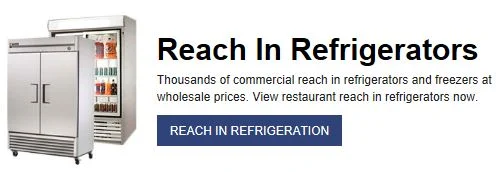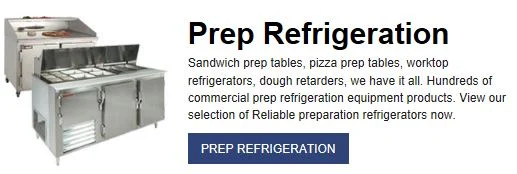
While commercial refrigerators and residential refrigerators serve the obvious purposes of keeping food cold, fresh, and properly organized, there are several notable differences between the two types. For starters, commercial refrigerators are larger, more durable, more powerful and more expensive than residential models.
However, despite their expense, there has been an increasing trend toward families purchasing commercial refrigerators for home use - though the primary use case remains as it should - restaurants, cafeterias and catering operations. Meantime, residential refrigerators do not belong in commercial settings - they're simply not built to last in an environment of heavy use.
This article will discuss the differences between commercial refrigerators and residential refrigerators before conducting an overview of commercial refrigerators.
Popular Commercial Refrigerators
UBDC60 SB54SC SDC10 UBDC48 UHBDC36 CBK77-D UPPT72 LS38 BDC10 USD54 USPT60 UGDS54 SD1.9L3
Differences Between Commercial Refrigerators and Residential Refrigerators
We're all familiar with residential refrigerators - we grew up around them and probably use one at home today. They are designed to accommodate a quantity of food typical of an average family. However, for a commercial operation, residential refrigerators just won't get the job done.
Apart from offering insufficient storage space, residential refrigerators offer weaker compressors and minimal insulation - both of which can lead to temperature fluctuations. Compounding matters further, inaccurate thermostats are common on residential refrigerators, and this trifecta can easily lead to health code violations.
Not to mention that residential refrigerators are generally more fragile because they typically are manufactured from materials other than durable stainless steel and that heavy commercial use will often lead to corrosion, damage, maintenance repairs and health code violations.
Pros and Cons of Commercial Refrigerators
Commercial Refrigerators are designed for heavy use, manufactured from durable stainless steel that is resistant to corrosion and stands up to the ongoing repetition of opening and closing the refrigerator door within a busy commercial kitchen for a period of many years.
Powerful compressors (that can be somewhat noisy) provide for optimal performance and commercial-grade materials resist bacteria, both of which are important features that meet or exceed health code requirements. Their temperature control system often includes an alarm system that triggers in the event of low temperatures or a forgotten open door, thereby making them far more suited for a commercial setting, as is their larger storage space.
Commercial refrigerators will often feature 49 cubic feet or more of internal capacity - more than double that of a residential refrigerator, which often comes in at a capacity of near 21 cubic feet.
However, because of their powerful cooling compressors, commercial refrigerators are less energy efficient and contribute toward higher electricity bills.
Additionally, don't expect to find drawers for storing produce and meat as are found in residential refrigerators, and don't expect to find storage bins on the inside of the refrigerator door, either. Instead, commercial refrigerators offer an abundance of shelves that are useful for stocking plastic bins that store various food items and supplies.
Types of Commercial Refrigerators
A commercial refrigerator is the most heavily used piece of equipment within the kitchen, and its placement plays a critical role in its overall efficiency and energy consumption.
As a general rule, the closer to the hot cooking area and production line, the smaller the commercial refrigerator that should be placed in that area. Single Door Reach-In Refrigerator/Freezers are therefore best placed here and can be used to store prepared meats and vegetables that are to be used same-day.
These can be re-stocked as needed from a nearby walk-in freezer, two-door refrigerator, or three-door refrigerator.
Walk-in Coolers and Freezers should be located in a receiving area where they store meat, poultry, fish, vegetables and bulk ingredients.
Two and Three Door Reach-in Refrigerators should be placed in the prep area where they store prepared trays of seasoned meat, poultry, and fish, along with salad dressings and sauces that are to be used throughout the upcoming week.
This type of commercial refrigerator can easily be re-stocked throughout the week from a nearby walk-in cooler or freezer. Meantime, Roll-In Refrigerators and Freezers include an empty cavity that accommodates roll-in racks that keep prepared food fresh prior to service.
These should be stored at or near the food prep area. Finally, Roll-Thru and Pass-Thru Refrigerators and Freezers should be located between kitchen prep areas and service stations where they also store prepared food prior to service.
Commercial Refrigerator Doors
An important consideration with commercial refrigerators is the door type, the choice of which should be contingent on the aisles, doorways and entrances of the kitchen, as well as the placement of other kitchen equipment. For instance, swing doors make loading and unloading inventory easier, but since they often remain open, the doors can block other areas within a smaller commercial kitchen.
Half doors are like swing doors that have been cut in half (think two small doors on top of two more small doors) and provide a similar loading/unloading advantage while conserving energy but also leave the kitchen area vulnerable to blocking.
Pass-thru Refrigerators have front and rear doors that allow staff to quickly and conveniently remove and serve prepared items as needed.
Commercial refrigerator doors are generally constructed as either solid or glass doors, with each material type having their respective advantages and disadvantages. Solid doors offer greater insulation and energy efficiency, and are easier to clean than glass doors.
Glass doors, with their clear visibility, result in employees being less likely to stand in front of an open door searching for a specific food item. This convenience comes at a price, however, as glass doors offer less insulation and energy efficiency than solid doors.
Popular Categories:

















































